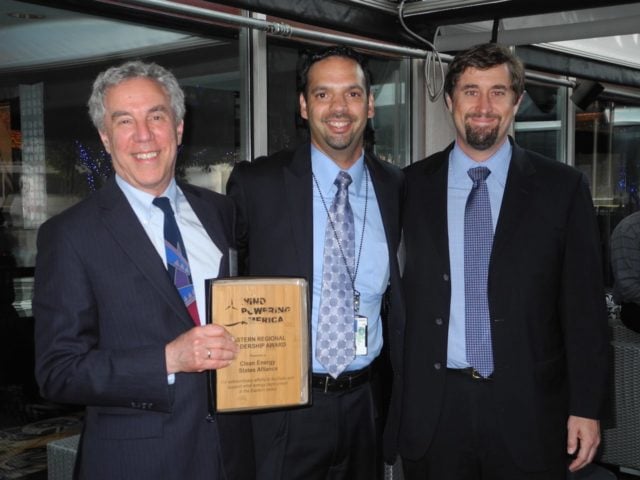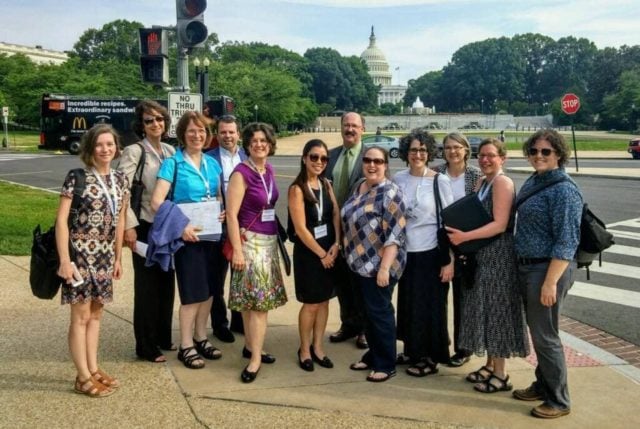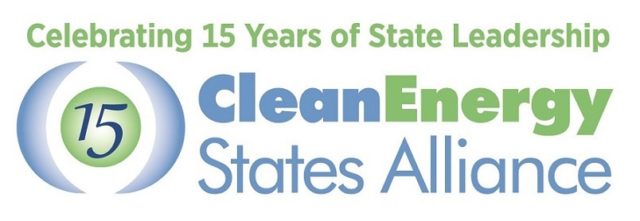Advancing Clean Energy: 15 Years of State Leadership
As the federal government has retreated from aggressive support for renewable energy, the states are increasingly seen as the locus for innovation and action. New regional and national coalitions of states have emerged to coordinate some of the states’ efforts. But long before the current focus on state action, some of the states joined together to form an important coalition dedicated to advancing clean energy.
That coalition started back in October 2002 when 40 representatives from recently created state clean energy funds, from foundations, and from the financial community met at Jiminy Peak Resort in Hancock, MA to discuss the creation of a collaborative nonprofit organization called the Clean Energy States Alliance (CESA). The purpose of the new organization was to provide better coordination of efforts and information-sharing among the various state public benefit funds to advance clean energy innovation and markets.
Now, 15 years later CESA is still going strong as its members benefit from collaborative programs and learning networks, technical assistance and research, and partnership development. The CESA organization represents state-level clean energy leadership. As it continues to support its members in the advancement of clean energy technologies and markets, the organization is also celebrating more than a decade of market transformation.
The Beginning
The emergence of state clean energy funds was a result of the deregulation of electric utilities in the late 1990s. Lewis Milford, president and founder of the nonprofit Clean Energy Group (CEG), had been advocating the creation of public benefits funds that would develop renewable energy resources. Through the work he had done as vice president at the Conservation Law Foundation, he was involved in many New England utility restructuring dockets. As the vertically-integrated utility model disbanded and competition arose for electricity suppliers, the question of how to incentivize clean, renewable energy came to the forefront. Some states found a solution in mandating a small surcharge on ratepayers’ electric bills – called a system benefit charge – that would go into a fund dedicated to developing clean energy resources.
Managers of these new clean energy funds were left with the task of figuring out how best to use the money to advance renewable energy deployment in their state. As Lew Milford explains, “These public benefit funds, established with the purpose of advancing clean and renewable energy generation, didn’t exist before. States were breaking new ground with every program they created. It made sense for them to share ideas on the best programs to establish and how to implement them.”
After the Jiminy Peak meeting, 15 funds from 12 states officially formed the Clean Energy States Alliance. The new nonprofit entity, managed and staffed by CEG, would serve as a networking space to coordinate the common efforts and goals of the participating clean energy funds.
One of the first collaborative efforts was a clean energy branding and public education campaign. This began in 2003 with five states working together to overcome market challenges facing renewable energy. The goal was to show that fossil fuel alternatives were available, viable, and up to the task of powering our world. The campaign used a simple slogan, “Clean Energy: It’s Here. It’s Real. It’s Working. Let’s Make More.” Working with Gardner Nelson & Partners and SmartPower, the public education campaign created a suite of multimedia tools, including radio spots, TV advertisements, posters, and a logo that were available for CESA member organizations to use.
Other early projects included a public fuel cell alliance, a marine and hydrokinetic energy project, wind siting and offshore wind projects, a solar PV advancement project, and an RPS implementation project. Over the years, as CESA member programs and the renewable energy technologies they work to advance have evolved, so too have the activities and projects that CESA has led.
Major Milestones
A primary policy driver for renewable energy deployment at the state level is the Renewable Portfolio Standard (RPS). From CESA’s inception, the organization has worked to help states implement their RPS policies, but that work expanded to a national scope in 2008 with the establishment of the State-Federal RPS Collaborative. Supported by funding from the U.S. Department of Energy and the Energy Foundation, the Collaborative’s purpose was to foster and facilitate dialogue among RPS managers regarding effective policy design and implementation, with emphasis on state-to-state and state-to-federal discussions. The Collaborative was essentially the only national forum for RPS administrators to network with one another. CESA managed this forum and engaged stakeholders in a series of webinars and national summits. The RPS Collaborative is an ongoing project with 29 states and the District of Columbia having RPS programs.
 Also in 2008, CESA established a national awards program to recognize exemplary clean energy projects and programs implemented by CESA members. The State Leadership in Clean Energy (SLICE) Awards highlight state-level programs that are most effectively accelerating adoption of clean energy technologies and advancing clean energy markets. The first SLICE awards were presented at the National Press Club in January 2009. CESA presented a second round of awards in October 2010, and every two years thereafter. This biennial awards program is also ongoing with the next awards to be presented in 2018.
Also in 2008, CESA established a national awards program to recognize exemplary clean energy projects and programs implemented by CESA members. The State Leadership in Clean Energy (SLICE) Awards highlight state-level programs that are most effectively accelerating adoption of clean energy technologies and advancing clean energy markets. The first SLICE awards were presented at the National Press Club in January 2009. CESA presented a second round of awards in October 2010, and every two years thereafter. This biennial awards program is also ongoing with the next awards to be presented in 2018.
“The SLICE awards are a great way to showcase state innovation around clean energy market development and share best practices between CESA members and other clean energy stakeholders across the country,” said Maria Blais Costello, CESA’s Manager of Program Administration, who has been with the organization since its founding. “One example of this replication is the Solarize programs that have taken hold across the country as a group purchasing model for solar PV. That program was started with assistance from Energy Trust of Oregon, a CESA member since 2002 and a winner of two SLICE awards.” Case studies and webinars on award winning programs can be found on CESA’s SLICE webpage.
In 2009 state clean energy funding received a boost from the American Recovery and Reinvestment Act. The federal stimulus bill earmarked $3.1 billion for clean energy through new State Energy Program funding. CESA assisted states as they grappled with how to best use this funding to advance clean energy. Specifically CESA provided information on financial incentives, program design and best practices. Nadeane Howard, director of the Ohio Energy Resources Division of the Ohio Department of Development at that time, noted that: “As Ohio develops and implements nearly $500 million in energy programs through the American Recovery and Reinvestment Act, we highly value CESA as an important resource for best practices and advice.”
 In 2011 CESA launched two initiatives to facilitate and accelerate the wind energy market. The Interstate Turbine Advisory Council (ITAC) strives to support certification, and strengthen the market, for small and midsized wind turbines. ITAC has produced a unified list of wind turbines that meet certain certification standards required by state incentive programs. For offshore wind, CESA created the Offshore Wind Accelerator Project (OWAP) to support stakeholders in tackling the major challenges facing offshore wind development in the U.S. OWAP activities over the years have ranged from a broad communications campaign, to maintaining an online database of offshore wind documents, to helping coordinate a project to develop a roadmap for multi-state cooperation on offshore wind. The Department of Energy recognized CESA for these wind energy initiatives by awarding the organization the 2013 Wind Powering America Eastern Regional Leadership Award.
In 2011 CESA launched two initiatives to facilitate and accelerate the wind energy market. The Interstate Turbine Advisory Council (ITAC) strives to support certification, and strengthen the market, for small and midsized wind turbines. ITAC has produced a unified list of wind turbines that meet certain certification standards required by state incentive programs. For offshore wind, CESA created the Offshore Wind Accelerator Project (OWAP) to support stakeholders in tackling the major challenges facing offshore wind development in the U.S. OWAP activities over the years have ranged from a broad communications campaign, to maintaining an online database of offshore wind documents, to helping coordinate a project to develop a roadmap for multi-state cooperation on offshore wind. The Department of Energy recognized CESA for these wind energy initiatives by awarding the organization the 2013 Wind Powering America Eastern Regional Leadership Award.
CESA also expanded its membership to include a second, “affiliate” tier. Affiliate members can include a wide range of state, municipal, and federal agencies that work to advance clean energy deployment. There are currently 13 affiliate members, in addition to the 17 core members.
These members have been instrumental in supporting the remarkable growth in renewable energy markets and deployments. Solar and wind power are now the fastest growing forms of new power generation. California leads the nation in installed solar capacity as of 2016, according to the Solar Energy Industries Association. Solar accounts for 13.39% of the state’s electricity, and nearly 5 million California homes are now powered by the sun. From 1998 to 2011, CESA member organizations supported the installation of about 32,000 solar PV projects. By contrast, California alone now has 691,748 distributed solar PV projects, according to California Distributed Generation Statistics. Another CESA member state – Iowa – leads the nation in wind generation as a percentage of total power output, 36.6% as of 2016. According to the Iowa Economic Development Authority, MidAmerican Energy, the state’s largest electric utility, now sources nearly half of its electricity from wind. In 2004 none of the utility’s generation capacity came from wind. As of 2011, CESA members had supported 259 total wind projects; by contrast, Iowa alone currently has over 100 wind projects online.
Looking Forward
CESA member organizations have invested literally billions of dollars in clean energy, leading to more than 10 gigawatts of generation capacity. But CESA’s impacts can be seen not only in the number of gigawatts installed by its members or in the billions invested in renewable energy projects by leveraging public sector funds with private investments, but also in the role it plays in facilitating exchanges between members that enable them to implement the most effective clean energy programs possible. “The real value is for our members to have a collegial space to share concerns, ideas, and best practices,” observes CESA Executive Director Warren Leon.
At a time when many issues including energy policy have become politically polarizing, having such a nonpartisan forum for states to work together and learn from one another becomes critical. “As the policymaking landscape has become increasingly politically contentious, the need for CESA has become greater,” Leon explains.
 CESA will continue working with states as they strive to meet their clean energy goals and standards. Some emerging areas that CESA is currently working in are energy storage and offshore wind. These technologies and industries are taking off, and CESA will be there to support members as they navigate the new markets. CESA also continues to work on initiatives to make clean energy affordable and accessible to all, with a particular focus on low-income households. This work will also be important in the years ahead.
CESA will continue working with states as they strive to meet their clean energy goals and standards. Some emerging areas that CESA is currently working in are energy storage and offshore wind. These technologies and industries are taking off, and CESA will be there to support members as they navigate the new markets. CESA also continues to work on initiatives to make clean energy affordable and accessible to all, with a particular focus on low-income households. This work will also be important in the years ahead.
States have long been innovators and leaders when it comes to clean energy. “States are the true laboratories for renewable program design and play a vital role in the development of renewable energy markets,” said John Geesman, former commissioner at the California Energy Commission, a CESA member organization. “As interest in renewable energy surges throughout the United States, CESA’s coordination role becomes increasingly important.”
Published On
August 15, 2017




